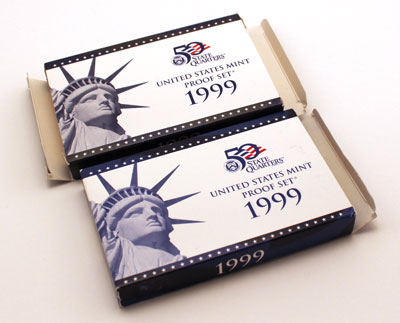Some of you proof set aficionados probably know this already. But, people who deal in proof sets for many years can be surprised by new observations at times too.
“What are you talking about,” you ask?
Well, recently while preparing a large number of 1999 proof sets to be sold, a difference in the US Mint’s outer packaging became obvious.
Let’s take a look.
Here’s the front of two 1999 boxes.
At a glance the two 1999 proof set boxes look the same. As you look closer, you can see the colors are slightly different. The blue colors on the top box are darker and a slightly different tone of blue.
You’re thinking skeptically to yourself, “Really?”
Let’s take a look at the back of the same two boxes.
The design on the back of the box shows a flag, perhaps unfurling in the wind.
On the top box, the red stripes are a medium gray. The blue background of the stars is a dark charcoal gray. The white stripes and white stars show as a blue color.
For the bottom box, the red, white and blue colors of the nation’s flag show in various tones of blue, no gray.
Still, unless you’re paying close attention to the colors, the two boxes look the same for the most part.
One other difference, however, clearly illustrates the two boxes are different.
The top, darker blue 1999 proof set box with the gray colors on the back opens via flaps at both ends.
The bottom box only has one flap opening on the right. Glue holds the left end of the box closed.
Now, if you remember your proof sets, the 1999 proof set was the first year to include two lenses. The addition of the five quarters for the first year of the state quarter program required either a much larger lens or two lenses to hold the nine coins. The US Mint chose to include two lenses in a larger, thicker outer box.
The 1998 proof set year included the last of the green, flap at the top box that housed only one lens with five different coins – the proof one cent, five cent, ten cent, quarter dollar and half dollar coins.
The 1999 proof sets held nine coins. The penny, nickel, dime and half dollar were held in one lens, and the first five quarters of the state quarter program came in the second lens.
It’s interesting that the US Mint changed the box mid-year. Subsequent years, at least through 2008, included a version of the Liberty front and flag back with the left end closed and right end opened format for the proof set box.
Did the US Mint learn that their new two-flap boxes were not very sturdy?
If you look at a group of 1999 proof sets and compare the two types of boxes, the two-flap boxes are frequently torn or tearing. Also, after you remove the proof set lenses to view the coins then place them back in the proof set box, the lenses get caught on the opposite end’s flap.
On the other hand, some people prefer to open boxes from the left rather than the right end. Some proof set boxes, not just 1999, arrive with the glued left end torn open. Not too often, but it does happen.
For those who collected just the five-coin quarter proof sets from 1999, their outer boxes also changed sometime in the 1999 proof set distribution. The early boxes had flaps at both ends just like the early 1999 proof sets. The latter 1999 proof quarter sets had one end of the box glued shut. (All of the 1999 proof quarter set boxes and their contents shipped out resulting in no pictures for those different types of boxes.)
So, did the US Mint decide the two-flap box was flimsy? Or, did they realize the frustration of the lenses catching on the opposite end’s flap when you went to replace the lenses in the proof set box?
And, when did they make the change? Was it when they decided to produce more sets and allow five per household rather than the initial two?


